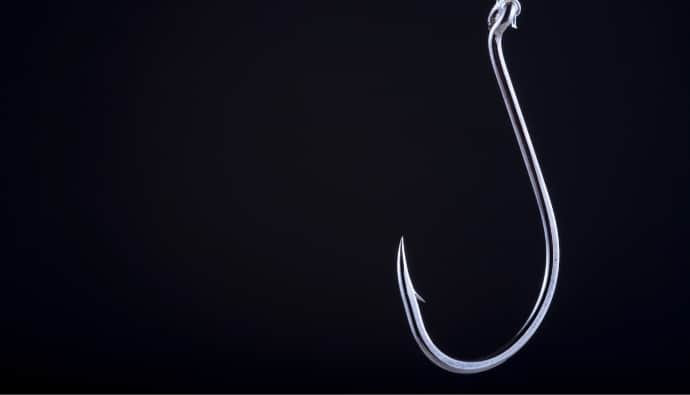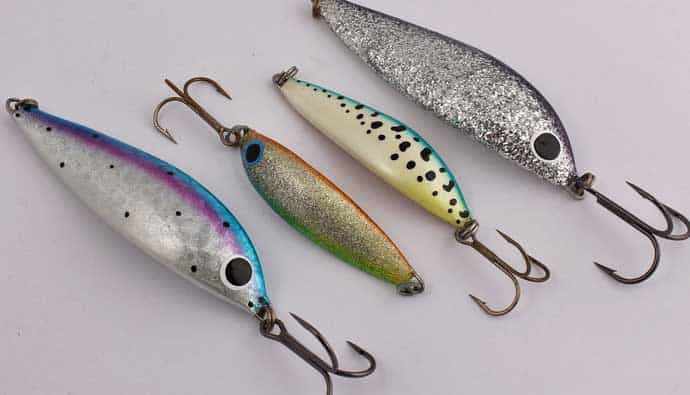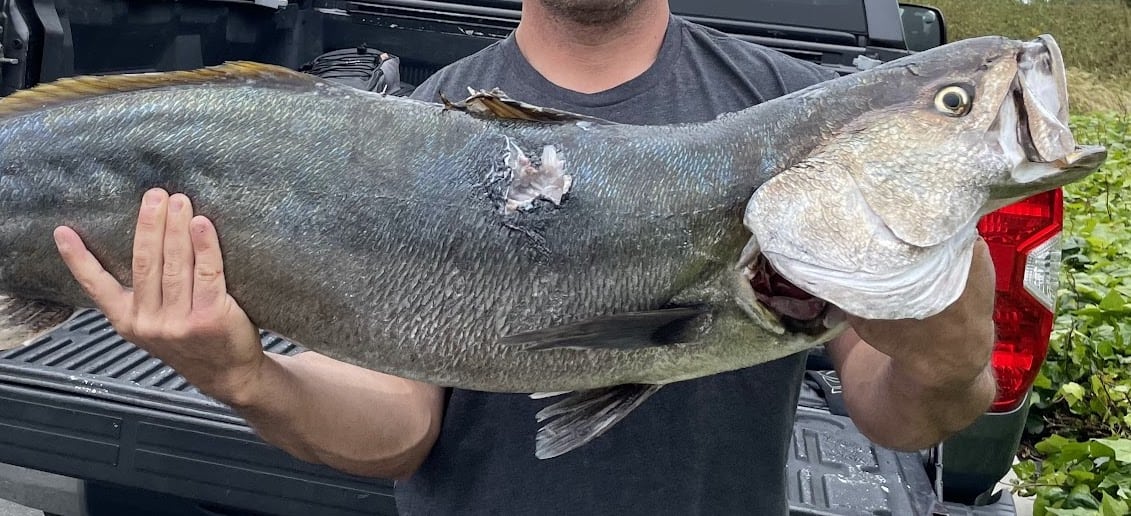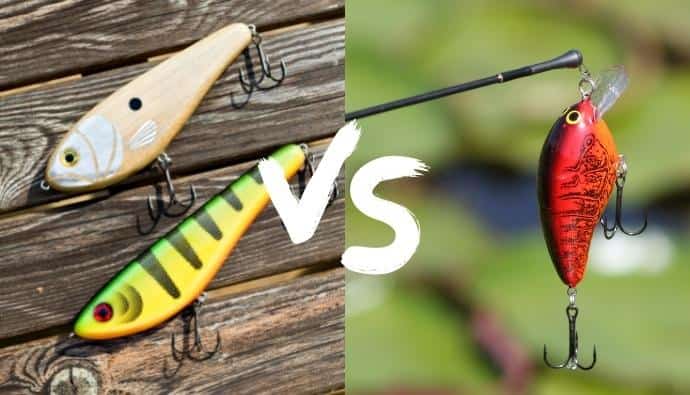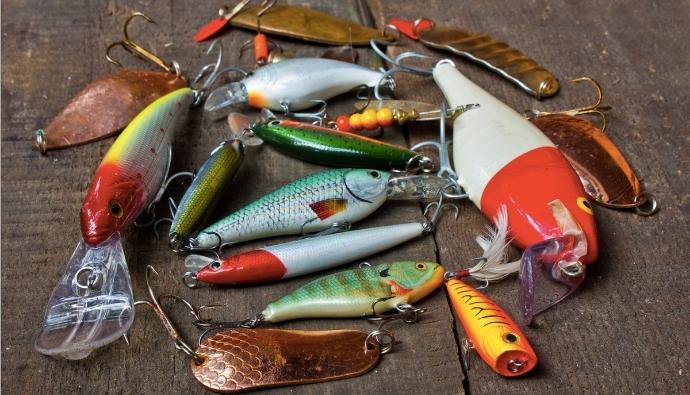A new fisherman needs to know the names of fishing lures standard in the industry.
This guide will show you the various freshwater trolling lures and casting lures essential to catch a wide variety of freshwater fish.
It is a well-known axiom, “what works for one will not necessarily work for the other.”
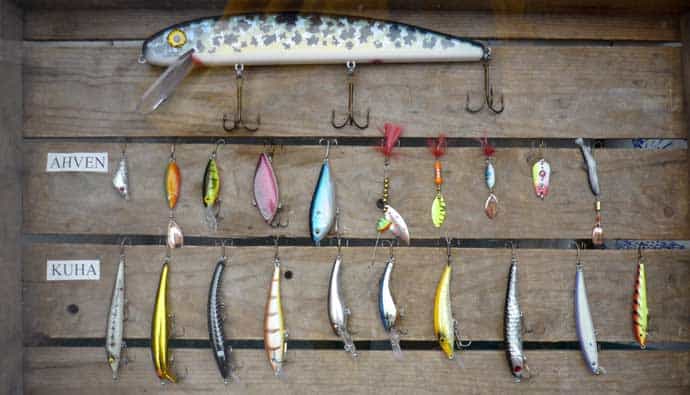
If you’re looking for quality saltwater and freshwater lures, here are a few of my favorites.
With tens of thousands of lures on the market, it can be challenging to choose what works best. Most anglers have a preferred arsenal of lures that are right for their area and the daily conditions where they fish.
Listen to more fishing tips on the Cast & Spear Podcast
In this guide, I am going to cover several of these behaviors and patterns as well as five basic lures that work very well in many scenarios and conditions.
We’re going to cover some of the most versatile fishing lures, including bass lures, topwater lures, and even some of those Walmart and bargain fishing lures that are easier to get on Amazon nowadays!
Also, I will cover techniques that work well with these lures and how to mimic prey that different species of predatory fish typically go after.
Names of Fishing Lures (a few):
- Jigs
- Swimbaits (Hard-body, Soft body, and paddle tale)
- Plugs
- Crankbaits
- Spoons
Know that we are acquainted with the names of the various topwater lures, let’s dive into detail dealing with how to use each one. We’ll cover which lure might be used to target specific fish and the best way to increase your odds of catching one.
Names of Fishing Lures
Below we’re going to break down the various types of freshwater and saltwater fishing lures that you should have in your arsenal. Remember, all recommendations are generalizations, and it’ll be up to you to try multiple items to see what works for the fish in your area.
Jigs
(Bass)
[amazon box=”B003CTOXP4″]
Bass are ambush predators, utilizing aggressive strikes, blind hits, and sudden hits throughout the water column. Distressed, injured, or sick, pray our prime targets for these opportunistic feeders. However, it doesn’t take food to trigger a bass strike. Territorial, these aggressive green fish will hit anything that enters their domain.
One of the hottest lures on the pro tours, the swimming jig, is often used just winding the jig through the water, just like a spinnerbait or lipless crank.
Perfect Jig Weight
The ideal swim jig ranges from ¼ to ½ ounce, has a lighter weed guard, and has a bullet-shaped head to slither around and over cover.
Because swim jigs are moving when the bass bites, they don’t need nearly as heavy a hook. You want something sharp and narrow for maximum penetration. Ideal swim jig trailers include grubs, paddle tails, craws, or other plastics with lots of action.
Jigs are highly customizable, so the uses of jig lures can be very vast. For example, jig weight, head shape, head color, skirt color, and trailer can change based on the conditions and the type of prey you are trying to mimic.
Swimbaits
(Bass, Pickerel, Pike, Musky, Striper, White Bass, and larger panfish)
There are three major types of swimbaits:
- Hard Body
- Soft Body
- Paddle Tail
Hard-Body Swimbaits
[amazon box=”B0010X8VXE”]
The detail on some hard-body swimbaits is extremely realistic, as is their action in the water. Due to their size and action, they often attract the biggest fish you are fishing with savage, handshaking strikes and vicious takedowns, sometimes inches from your feet.
It can be quite exciting when the swimbait bite is on, though the bites may not come fast or easy.
Cost of Quality
The price of quality hard-bodied swimbaits is so high due to the extreme fine-tuning by the creators to re-enact a real fish. The professionals and serious anglers are likely to pay upwards in the hundreds for a fine-tuned swimbait that draws the gigantic fish around to strike it.
The cost of high-quality hard-bodied swimbaits is so high due to the extreme fine-tuning by the creators to re-enact a real fish in both appearance and action in the water.
Swimbaits, in general, lean more towards the expensive side, but as with anything, there is a cheaper side to them, usually at the sacrifice of tuning, sink rate, or quality of build or action.
Treble Hooks
As expected, the hard-bodied variant is typically equipped with treble hooks, far from being weedless or snag-free.
Much of the time, you can rip them through the grass or treetops as they are so large, but they ARE expensive, so the idea is not to lose them to a piece of grass or a tree stump. These types of techniques require beefy bass fishing gear, heavy rods, and reels designed to cast and retrieve such large baits. This is a specialty niche, for sure.
Some hard-bodied swimbaits have a lip in the front to aid them in keeping their action consistent, like a crankbait. Some of the more expensive models do not require a mouth in the front and are designed to glide or swim well through the water like a real fish.
Soft-Bodied Swimbaits
[amazon box=” B008JCBZQO”]
These fishing tackle lures are usually huge, heavy, solid plastic lures. They also make great topwater bass fishing lures!
The reason many anglers pick them over their hard bodies cousins is that they are soft; the fish get to imitate a realistic feeling when they strike, which in turn gives the angler more time to set the hook. Besides, these baits are often more natural to produce at a lower price than hard body counterparts.
These lures are created out of a very durable plastic that is very abrasion, and tear-resistant are resilient.
Types of Soft Baits
There are a few different types of soft baits. There are full-body, line-through, and top hook variants of soft baits.
Full-body baits are whole plastic baits that require you to rig your hook to them.
The line-through baits require you to run your choice fishing line through a little tube going through the bait’s body and attaching a treble hook to your line.
The line through the bait allows the line through baits to slide up and down. This feature keeps your bait from becoming damaged and having to re-tie another one on and therefore preventing the fish from shaking the hook as quickly due to the weight being up the line.
Top hook baits are pre-rigged and pre-weighted baits that you tie on your line and throw. These baits are the simplest and cheapest variant of soft-bodied swimbaits.
Paddle Tail Swimbaits
[amazon box=” B0084EGI8W”]
Paddle tail swim baits are underutilized but incredibly effective soft plastic. These cheap beats can be hooked several different ways and come in packs varying in both size and color.
One of the most effective parts of these paddle-tail swimbaits is the overt movement of their “paddle” tail. This tail, oversized and obnoxious, creates a disturbance in the water and an excessive amount of motion to attract the attention of the bass.
These types of baits require you to rig them up yourself. This allows for various amounts of different ways to fish this type of swimbait. (They are my personal favorite, as well as my go-to for finding fish in new waters.)
Texas Rig Setup
You can Texas-rig them; To rig a Texas rig, all you need is a bullet weight, and some worms hook. You can use an offset round-bend hook or an offset-EWG (extra wide gap) hook.
The EWG hook works better for swimbaits in snag-prone situations because it aids in making the swimbait more weedless. After you have gathered your terminal fishing tackle, you need to put the bullet weight point first on the line, then tie your hook.
Setting Up Your Swimbait
Next, you need to put your swimbait on, get your bait, take the point of the hook, and put it at the center of the bait as possible.
Push the hook till you get to the end of the straight portion. Pull the hook through the bottom side of the swimbait and push the bait up to the eyelet. At that point, you should put the hook up against the front of your bait and see where the round bend starts on your hook.
Hold the bait there, turn your hook around and push the point of your hook through the belly. Go through the back where you have the bait held and let the straight portion of the hook rest against the back of the bait.
Look for the Notch
Most of the time, Paddle tail swimbaits have a notch for the shank of the hook to rest so that the bait is weedless.
If your bait does not have the little notch, pull the bait forward a bit and let the tip of your hook rest just below the surface of the plastic. This will keep you from getting snagged on weeds, grass, stumps, and tree limbs.
Alternatively, there are swimbait hooks you can purchase that have a little spring on the eyelet that allows you to screw your bait onto it and through the belly for ease.
Most of the time, swimbait hooks are weighted, but some versions are not. A much easier way to rig your swimbaits is with a simple jig head, which is not suggested by most because you WILL get snagged on everything in the water if you fish in snag-prone situations. If you troll a swimbait, nose hooking can be a way to go if snags aren’t a problem where you fish, especially if you use a three-way rig.
Plug Lures
(Bass, White Bass, Wipers, Perch, Muskellunge, Murray Cod, Pike, Striper, Peacock Bass)
[amazon box=”B003DSA7RC”]
Many standard plugs float on the surface or suspend in the water but will dive under the surface of the water and swim with a side-to-side wobbling movement upon retrieval, which usually consists of slow to medium-fast reel-in, sometimes with pauses or sweeps of the rod.
This makes the bait seem like a real fish that attracts predatory fish such as bass and pike.
Designed to Hover
Plugs can also be designed to hover (neutral buoyancy), sink slowly, or sink rapidly. Some have a small metal ball inside to “rattle” when retrieved.
Each plug has its action or has none unless you give it one. Wood plugs usually range from between 3/4 oz. And 4 oz. The different plugs come in a few basic categories.
There are surface swimmers, subsurface swimmers, poppers, pencil poppers, and darters. They all have their specific place and time to be fished and are considered to be the best roosterfish lures.
Plug Sizes
Plugs range in size from around an inch (3 cm) to around 8 inches (20 cm). Plugs in the 3-6 inch size range are common.
Make no mistake, though, large fish will, and often do, eat small lures. Keep this in mind when you are throwing presentations to areas where large fish may be present.
Fishers casting for tiny fish such as crappie will use tiny plugs, and anglers fishing for large fish such as muskellunge, striper, or Murray cod will use huge plugs.
Trophy-sized fish caught on tiny plugs and fingerling perch will sometimes strike — and hook themselves — on a plug as big as they are themselves.
Largemouth Bass Hit Large Lures
Largemouth bass, especially at small sizes, will frequently hit lures as large as they are, as a matter of course. Massive green sunfish have been known to attack large swimbaits out of territorial instinct, etc.
Plug fishing is more common in the freshwater fishery than saltwater fishing, but it is growing considerably among East Coast striper fishers.
Most plugs have their “action” built into them by design. Still, good fishermen give a signature to the plug’s action in many ways, such as varying the speed of the reel retrieve, occasionally “twitching” the rod tip during the retrieve, or even letting the plug stop entirely in the water, then resuming retrieve at a very high speed.
Use the Fish’s Instinct Against Them
This uses fish instinct to attack fleeing prey and wounded creatures that may move out of sheer desperation. This approach to fish biology has proven very successful in many scenarios.
Plugs are often cast, so they land next to places where fish may be hiding, such as a snag pile or an overhanging tree, and work back enticingly. A skilled fisherman can methodically explore many possible hiding places for fish by continually casting and retrieving a plug.
Theoretically, any plug design will catch fish (most anglers use them to catch bass). Fish will, out of anger, hunger, territorial protection, or pure curiosity, occasionally strike at any small object moving or falling through the water.
Putting this object in front of the fish becomes the fisherman’s primary concern.
But some plugs have become famous for their high degree of effectiveness in the hands of a good fisherman, while others come and go from the market quickly when found to have limited success.
Crankbaits for Bass
(Bass)
[amazon box=”B012V0C7V6″]
A crankbait is a great lure and fishing gift when an angler wants to explore various depths.
What allows the crankbait lures to dive at different depths is the bill at the head of the lure or, in some cases, the lures’ sink rate. Crank bill size and shape dictate the amount of dive each crankbait has.
Late fall and early spring, when the bass are roaming shallow water (or nearly any time if the body of water is shallow or warm enough), is the best time to use a square bill crankbait. This is a short bill crankbait that can be retrieved slowly through the still-cool water and brush but still be retrieved at high speeds to deflect off of stumps and submerged trees. This mimics the flash pattern of wounded prey fish.
Line Diameter Matters
Fishing crankbaits on the incorrect diameter line can cause all manner of issues. If you go too heavy for a certain crankbait, you will have almost no casting distance at all, and if you go too thin, you can easily break off 40$ of crankbaits in your first five minutes of fishing. The key is to match the size of your line to the lure you are using.
Casting a Yo Zuri to snap bean on the 40# line makes as much sense as throwing a 2 oz hydro minnow on 4#. Use a line that will allow you to get to the depth the crank is designed. In some cases, this will be a short section of mono or fluoro leader to the best braided fishing line you have on the main reel for casting distance, the mono providing abrasion resistance as needed.
Water Clarity Matters
Water clarity plays a factor in which crankbait to throw. In murky water, a wide, wobbling crankbait that is retrieved slowly will usually produce the best result. Frogs work well here too.
When it comes to clear water, the best crank bait is a thin flat-sided one. The tighter the wobble, the better it looks. In a lower-light situation or murkier water, the situation dictates that the fish should find the lower itself, reducing the chance of a missed strike.
The thin-flat-sided crankbait is also an excellent choice to produce a strike from pre-spawn bass when retrieved at high speeds when the water warms to 50 degrees or higher.
Crankbaits are not considered weedless; however, the bill does aid in deflecting the lure from underwater objects that an ordinary diving lure may snag when retrieving.
Make sure you get a pack of crankbaits so you can see which works in your waters!
Spoon Lures
(These work well with most fish species)
[amazon box=”B0000AUV2B”]
A spoon lure, in sport fishing, is an oblong, usually concave lure, usually made of metal or a shell shaped like the bowl of a spoon.
The spoon lure is mainly used to attract fish by reflecting light and moving randomly, just like how a houndfish and needlefish get attracted to shiny spoon lures.
Fish use their lateral line system to follow movement in the water produced by the vibrations of fleeing prey. When the spoon catches light and spins in the water, this looks to the fish like fleeing prey and will usually produce a strike. These versatile lures are great for a vast number of applications and uses.
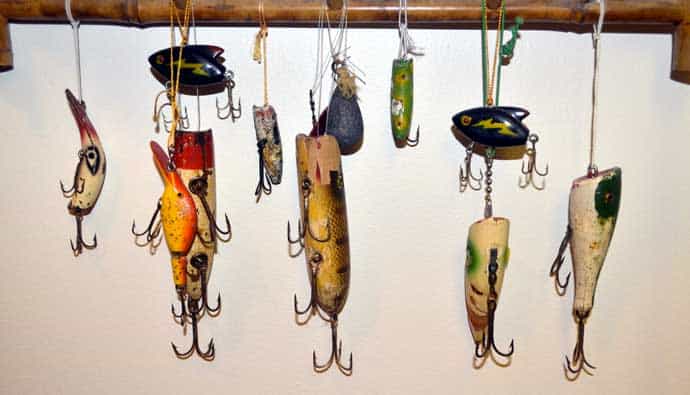
The action of a spoon is based on its shape and thickness. A long spoon will display a wider side-to-side wobble than a shorter spoon. A deep concave spoon will also produce a wider wobble than a flatter spoon.
Spoons used for trolling have an erratic wobble (this will help cope with line twists) compared to thick spoons, but thick spoons have advantages as well. The extra weight casts better, sinks faster, and will run deeper than thinner spoons. Additionally, they can be used in more vertical presentations (jigging) more easily.
Control Your Trolling Speed
Speed is critical for success when casting or using one of the best trolling lures; if fished too slow or too fast, the spoon will not wobble properly and may exhibit severe line twists. Experiment to find the precise speed for each spoon to perform its best.
When casting a spoon, anglers will typically cast 10 to 20 feet beyond the area they believe the fish are in and retrieve through the strike zone.
For flatline trolling from behind a boat, the speed and amount of line out should be the primary consideration, as well as in using depth control riggings such as downriggers and dipsy divers.
You can never go wrong with Acme Kastmasters or spoons like the Krocodile!
Best Fishing Lures No One Talks About
As an angler, sometimes it’s nice to try something out of the ordinary. Here are some lures that we’ve found that are under the radar and worth taking a look at if you want to spice up your fishing tackle box.
Rooster Tail Lures
These lures have feathers covering the hook that resemble a rooster’s tail. These are effective for catching bass and are common in most panfish and trout fishing tackle gear. These lures are deadly for a wide variety of species across the globe for sure.
These spinnerbaits come with a spinner attached to the front that rotates when you reel in at moderate speed and attracts the fish with shine and movement.
Here’s a good one worth trying:
[amazon box=”B003CU24FE”]
Phoebe Lures
These lures are made by Acme and look like a spoon that’s been cut out to look like a fish. These have a 3D profile, and they rotate through the water when you reel them in.
They have a cool three-dimensional illusion when you pull fast enough. Reel too quickly, and they will twist your line, keep this in mind.
These work well on small trout, perch, crappie, or whatever other small shad-eating panfish you’re targeting.
[amazon box=”B0000AV0RO”]
Dardevle Spoons
These Dardevle spoons are highly regarded, and some might say they are the number one lure to bring with you on the lake, especially for pike and walleye in the northern US and Canada. They are a great all-around fishing lure!
This spoon will help you catch walleye, pike, musky, and pretty much anything else that’s hungry in the water.
The wobble and flash that this produces when getting dragged through the water are top-notch!
[amazon box=”B0000AUVBO”]
Hula Poppers
Do you know why they call it a popper? It’s because when you drag them through the water, they make a popping noise that will attract fish! Some leave a great bubble trail in the water for fish to hone in on them well.
This is a must for all freshwater gamefish. If you’re into topwater fishing, then this is your topwater lure! These have been tried and true for well over 60 years.
This fishing tackle lure is excellent using a double loop knot and an eight to 10-pound test fishing line, depending on lure size and gear. Cast it out far and take your time pulling it back in…you’ll know when you get the bite!
Wait just a second before setting the hook-often as fishermen, I have done and witnessed other people setting the hook when the fish blows up on the lure instead of waiting for the fish to get the lure in its mouth, leading to severe frustration.
[amazon box=”B002QG0LFK”]
Good Luck Out There!
The creation of the original fishing tackle lure can be dated back to the 1890s when James Heddon created the first known wooden lure that would go into production for commercial sale.
This lure was highly successful and paved the way for the lures we are familiar with today.
Now, with thousands of options for fishing tackle and lure combinations, there are sure to be lures that’ll work for you. If you haven’t tried some frog lures, try those as well on some lilypads for bass.




 Facebook
Facebook YouTube
YouTube